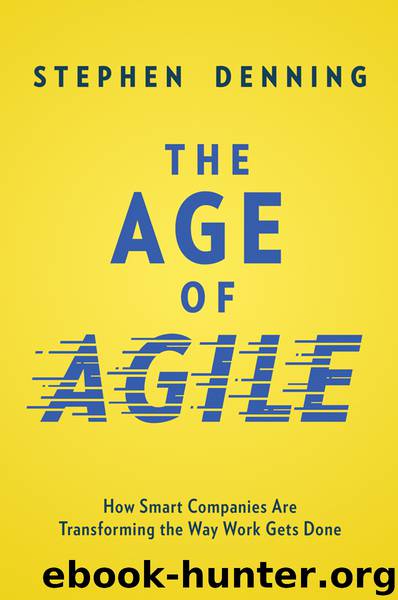The Age of Agile by Stephen Denning

Author:Stephen Denning
Language: eng
Format: epub
Publisher: AMACOM
Published: 2018-03-17T04:00:00+00:00
In today’s paradoxical world of business, where many public corporations focus on maximizing shareholder value as reflected in the share price, the situation is the reverse. CEOs and their top managers have massive incentives to focus their attention on fixing the share price in the stock market, even at the cost of hurting the firm. Thus, a survey of chief financial officers has shown that “78 percent would ‘give up economic value’ and 55 percent would cancel a project with a positive net present value—that is, willingly harm their companies—to meet Wall Street’s targets and fulfill its desire for ‘smooth’ earnings.”4
The real world of business is the world in which factories are built, software is developed, and real products and services are designed, produced, and sold that make a real difference in customers’ lives. Real dollars of earned profit show up on the bottom line. In a healthy economy, firms focus on creating real value for customers. The economy steadily grows.
The real world of business differs from the stock market, where shares in companies are traded between different kinds of investors. In the stock market, investors assess the resources and activities of a company today. Based on that assessment, investors form expectations as to how the company is likely to perform in future, as well as how much value the firm will return to its shareholders. The consensus view of many elements—the views of actual and potential investors, assessments of the current worth of the company, and the firm’s plans for returning value to shareholders—combine to determine the stock price of the company. Some investors are in it for the long haul; others are traders out to make short-term profits from the volatility of the market.
In the current stock market, the best managers are seen as those who meet expectations. “During the heart of the Jack Welch era,” writes Martin, “GE met or beat analysts’ forecasts in [46 of 48] quarters between December 1989 and September 2001—a 96 percent hit rate. Even more impressively, in 41 of those 46 quarters, GE hit the analyst forecast to the exact penny—89 percent perfection. And in the remaining seven imperfect quarters, the tolerance was startlingly narrow: four times, GE beat the projection by 2 cents, once it beat it by 1 cent, once it missed by 1 cent, and once by 2 cents. Looking at these twelve years of unnatural precision . . . What is the chance that could happen if earnings were not being managed?” Martin replies: “Infinitesimal.”5
In such a world, it takes a dedicated chief executive to do the hard, long-term work of undertaking innovation in an increasingly competitive marketplace populated with unpredictable customers. It’s much simpler, easier, personally safer, and more lucrative to boost the stock price by cutting costs to enhance the apparent short-term performance in the firm’s quarterly earnings, or to use financial engineering to extract value for shareholders.
In fact, a CEO of a public company has little choice but to pay careful attention to the stock
Download
This site does not store any files on its server. We only index and link to content provided by other sites. Please contact the content providers to delete copyright contents if any and email us, we'll remove relevant links or contents immediately.
Hit Refresh by Satya Nadella(8854)
The Compound Effect by Darren Hardy(8508)
Change Your Questions, Change Your Life by Marilee Adams(7372)
Nudge - Improving Decisions about Health, Wealth, and Happiness by Thaler Sunstein(7242)
The Black Swan by Nassim Nicholas Taleb(6764)
Deep Work by Cal Newport(6563)
Daring Greatly by Brene Brown(6223)
Rich Dad Poor Dad by Robert T. Kiyosaki(6175)
Principles: Life and Work by Ray Dalio(5961)
Man-made Catastrophes and Risk Information Concealment by Dmitry Chernov & Didier Sornette(5647)
Playing to Win_ How Strategy Really Works by A.G. Lafley & Roger L. Martin(5499)
Digital Minimalism by Cal Newport;(5389)
Big Magic: Creative Living Beyond Fear by Elizabeth Gilbert(5351)
The Myth of the Strong Leader by Archie Brown(5237)
The Slight Edge by Jeff Olson(5200)
Discipline Equals Freedom by Jocko Willink(5157)
The Motivation Myth by Jeff Haden(5003)
Stone's Rules by Roger Stone(4857)
The Laws of Human Nature by Robert Greene(4773)
